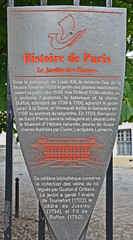King Louis XIII of France


King Louis XIII of France
(1601-1643)
King of France (1610-1643) and King of Navarre (1610-1643)
Family tree
Commemorated on 1 plaque
Le Jardin des Plantes Sous le patronage de Louis XIII, le médecin Guy de la Brosse fonde en 1633 le jardin des plantes médicinales, ouvert au public dès 1645. Aux XVIIe et XVIIIe siècles, on y professe l'anatomie, la botanique et la chimie. Buffon, intendant de 1739 à 1788, agrandit le jardin jusqu'à la Seine, et Verniquet édifie le belvédère en 1788 au sommet du labyrinthe. En 1793, Bernardin de Saint-Pierre ouvre la ménagerie et Lakanal crée le Museum d'Histoire naturelle, pourvu de douze chaires illustrées par Cuvier, Lacépède, Lamarck. Sa célère bibliothèque conserve la collection des vélins du roi légués par Gaston d'Orléans. Le jardin a gardé l'érable de Tournefort (1702), le cèdre de Jussieu (1734) et l'if de Buffon (1750).
English translation: The Jardin des Plantes Under the patronage of Louis XIII, the doctor Guy de la Brsse founded in 1633 the garden of medicinal plants, opened to the public in 1645. In the 17th and 18th centuries, anatomy, botany and chemistry were professed. Buffon, intendant from 1739 to 1788, enlarged the garden to the Seine, and Verniquet built the gazebo in 1788 at the top of the maze. In 1793 Bernardin de Saint-Pierre opened the menagerie and LakAnal created the Museum of Natural History, with twelve chairs illustrated by Cuvier, Lacépède, Lamarck. Its heavenly library preserves the collection of king's bellies bequeathed by Gaston d'Orléans. The garden kept the maple of Tournefort (1702), the cedar of Jussieu (1734) and the yew of Buffon (1750). [AWS Translate]
Corner of rue Geoffroy St. Hilaire and rue Buffon, Paris, France where they was

